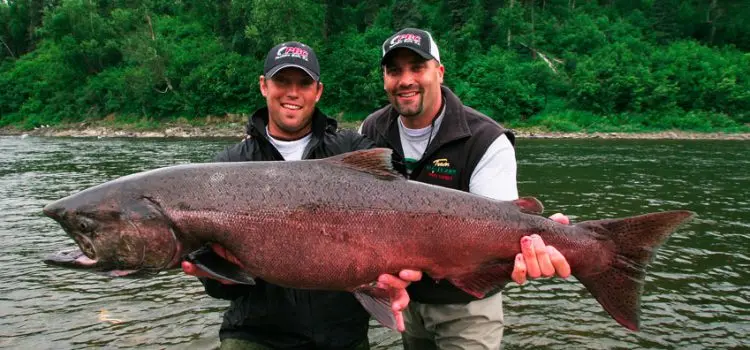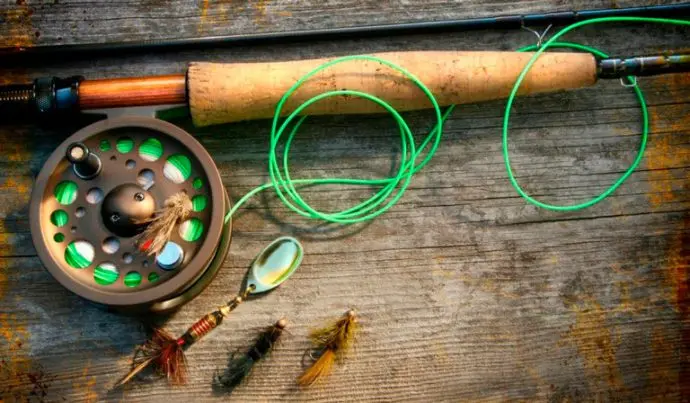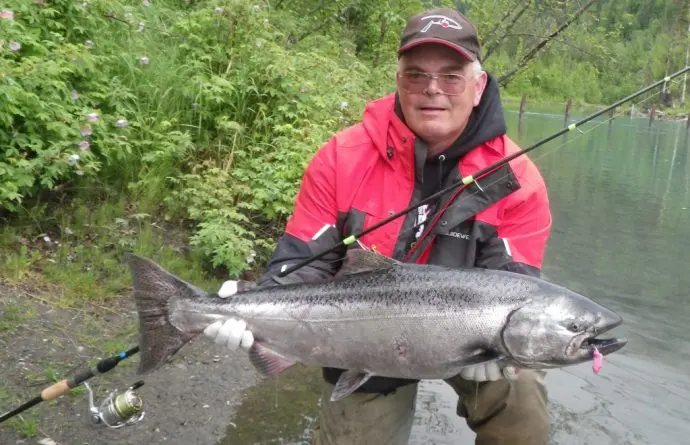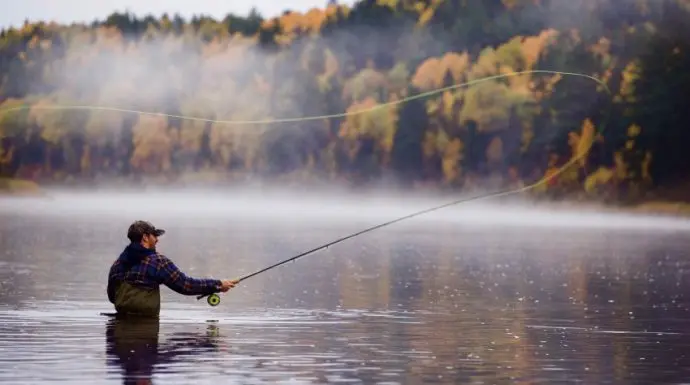Contents

A fish like salmon does not exist in nature. The term salmon is a generalized representation of fish of the salmon family. This family includes such fish as trout, whitefish, seal, grayling, lenok, pink salmon, salmon, malma, chum salmon, omul and others. This family includes a fish that is very rare in modern times – the white salmon. The salmon family, in turn, is divided into three subspecies: salmon, harpus and whitefish.
Salmon are migratory and freshwater. Anadromous species include species that inhabit the Pacific and Atlantic oceans, as well as the seas, while they enter rivers to spawn. Freshwater salmon are fish species that live permanently in lakes and rivers.
Salmon spawning begins in early spring, where it remains in the rivers until late autumn. Some of the species are sent to spawn only in September-October. For some time before spawning, the body of salmon undergoes serious changes. The shape of the jaws is modified: the upper ones bend down, and the lower ones bend upwards. Salmon changes its color to a brighter one. In addition, there are changes in the function of the intestines, stomach and liver. The meat becomes softer, which loses its value.
What tackle is used to catch salmon

Salmon are caught with well-known tackle such as fly-fishing, spinning and float rods. Regardless of the fishing tool, you should choose reliable and powerful gear. The fact is that salmon can be of impressive size. They can grow up to 2 meters in length and at the same time have a weight of about 70 kg. At the same time, salmon is a very strong fish and it is very difficult to cope with it without a certain experience. It has an impressive reserve of energy, which helps it overcome huge distances against the current. Therefore, the struggle is going to be serious.
Spinning salmon

Spinning is one of the most versatile gear, moreover, quite easy to use. In any case, it is best to start spinning salmon and only then move on to more complex gear, such as fly fishing.
For fishing with spinning, in small rivers, an ordinary spinning rod is suitable, 1,8-2,4 meters long, having a rigid system and a test from 10 to 40 grams. Quite often, for salmon fishing, rods with larger diameter guides (up to 40 mm) are used. This makes it possible to cast light lures farther away, as well as to complete tackle with thicker fishing line. If it is supposed to catch on a large river where larger individuals are found, then it is better to give preference to a two-handed spinning rod, 2,4-3 meters long. All elements of gear must be selected taking into account the expected catch. As a rule, spinning is equipped with high-quality fishing line, which has a thickness of 0,3-0,4 mm. If really large individuals are caught, then you can opt for a fishing line with a thickness of 0,45 mm.
The choice of lures is very important, which depends on many factors, such as the speed of the current, the depth of fishing, the presence of wind, and the casting distance. In the presence of a moderate current, not large turntables or wobblers are selected, and in the presence of a large current, baits weighing 40-50 grams cannot be dispensed with.
The spinner is carried out directly at the bottom. Depending on the weight of the bait, the thickness of the fishing line should also be selected. At the same time, all elements of the bait must be of high quality, including swivels, carabiners and clockwork rings. Therefore, hunting for salmon requires a scrupulous approach to picking tackle. Particular attention should be paid to the quality of the tees. If a cheap model is used, then you should protect yourself from fish coming off. To do this, very often experienced anglers change factory tees for better branded ones. When choosing a spinner, you should pay attention to its play: a spinner should work at minimum wiring speeds, and oscillating spinners should not have a very sweeping game.
Catching big salmon on spinning. Andrey Pitertsov
salmon fishing technique

Having entered the river just before spawning, the salmon refuses to eat, but at the same time, it attacks baits of various origins. This is due to the fact that he, as it were, protects the spawning ground from uninvited guests, in the form of flies and baubles. Lures and flies are no different from each other, so they can be used both for spinning and fly fishing. On the diagram you can see how casting and wiring are carried out correctly. Moreover, the diagram shows one of the options. For example, a salmon may be behind a rock, in a shelter where there is no current. To make the right cast, you should take into account the speed of the current and the depth so that the bait passes in close proximity to the fish. Under the influence of the force of the current, the lure looks good, directed against the current. The wiring can be completed at the moment when the spinning line or fly line is aligned with the shore.
If there are no bites, then something is being done wrong, and the wiring diagram will have to be changed. In addition, you can think about replacing the bait itself, or change the speed of the wiring. Salmon react more to baits that move at a slower speed. A salmon bite is somewhat similar to a hook. He can grab the lure and swim with it in the direction of its movement. Feeling something similar, you should immediately cut.
If a large specimen is hooked, then you need to be prepared for a confrontation, and a serious one at that. Therefore, the one who miscalculated with the reliability of gear will quickly regret it. To take a salmon, you need to tire it out, but the extra freedom can be costly. Salmon can get tackle behind some cover and cut it off. On the one hand, haste may turn out to be unnecessary, and on the other hand, the process should not be delayed either.
Fly fishing for salmon

Fly fishing for salmon requires the right gear. As a rule, it differs from the traditional types of gear that are used to catch salmon and other types of fish. The choice of all elements of gear depends on the fishing conditions, as well as on the ability of the fly fisher to use this gear. Both one-handed and two-handed types of rods are used, with a length of 2,7 to 5 meters. At the same time, you should always remember that this type of fishing involves frequent casting. In this regard, lighter rods should always be preferred. Otherwise, it will be difficult to enjoy the fishing process, but stretching the muscles of the hands is easy. In turn, the rod is selected under the cord, which has a 9-12 gravity class.
Recently, our fishermen have also begun to master fly fishing. In the process of casting, fly fishing can be held with one or two hands, sending the fly to a distance of 30-40 meters. Fly fishing distinguishes between “wet” and “dry” casts, depending on the type of bait used. “Wet” flies are designed for conducting in the water column, and “dry” flies are used when fishing from the surface. Both flies imitate various insects. It should be noted that fly fishing is used for fishing and other fish. To be precise, almost all types of fish can be caught by fly fishing, with the exception of some predators, such as pike, pike perch, catfish, etc., which prefer to lead a bottom lifestyle.
The only disadvantage of this method of fishing is that you need to make several casts as training. This tackle is not so easy to handle and, if you take it in your hands for the first time, then fishing will not take place. It is very important to make accurate casts to the places where the fish are supposed to be. It is not so easy to make such casts without preliminary training. The fly fishing technique is based on several independent stages: casting over the head to the desired point, hooking and playing the fish. Despite the certain independence of the stages, they all constitute a special type of fishing.
Salmon hooking is a separate topic for conversation. Sometimes he captures the fly, accompanying the process with a splash. In this case, everything is clear and you can do cutting. And if there is no surge, but only a certain resistance is felt. In this case, the fish should be accompanied, pending its further actions.
Fly fishing techniques have been honed over the years. The effectiveness of fishing depends on many factors, including the choice of fly, its size and its colors. There are many types of flies, both “dry” and “wet”, as well as with and without wings. Flies for salmon fishing can look like this:










